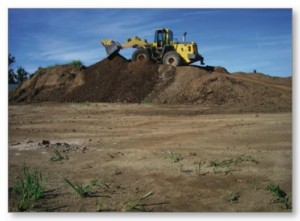
Sand and Gravel operation. Photo credit: Toronto Environmental Alliance
Water and Land Use and Forensic Meteorologist for gravel, aggregates, crushed stone operators certainly land use issues to deal with. There operations are essential to construction, transportation and the infrastructure that supports the world. The mining of this material takes place everywhere and environmental consequences must be mitigated for the successful operation of the pits, mines and quarries to remain viable.
Of great concern is the loss through evapotranspiration of surface ground water and the possible effects on the water table. Briefly, transpiration is the movement of and loss of moisture through the leaves of plants and trees. Combined with evaporation this represents a loss back into the atmosphere of accumulated moisture. Rainfall of course is important in recharging the water table.
Evapotranspiration cycle, photo credit Wikipedia,
In any particular pit ponding may occur from rain, snow or surface runoff. Excess loss of water is of particular importance to many local communities which may be in proximity to a quarry. As with any surface disturbance the chance of ground water contamination may exist. Water loss, especially in the Inter Mountain West, but even in more moist climates is an issue the quarry operator must address.
Mitigating such moisture loss can be addressed by performing material removal in winter when less surface heating slows evaporation. Planting grasses, shrubs and trees on the perimeter of the pond will shade the water surface also slowing evaporation. Care in choosing plants must be taken to prevent the accumulation of plant debris in the pond which may encourage other negative effects which are outside the scope of this article.
The role of the Forensic Meteorologist is to gather and analyze the data collected on site to determine the facts in the case and documents provided.
Article written by Robert Morthorst and edited by Operational Meteorologist Michael Fagin